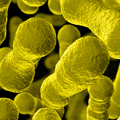 The cloning and expression of proteins to product recombinant proteins is a hugely popular technique that allows for the production of copious quantities of protein that almost mimic native proteins. Although a popular and useful technique, one of the main reasons for its use can also be a drawback. In some cases, over-expression of the recombinant protein leads to an accumulation of misfolding protein that aggregates and is sequestered into inclusion bodies. The purification of inclusion bodies is time consuming, involves harsh denaturants, detergents and other chemicals, resulting in damaged and denatured proteins. If a researcher is successful in extracting these proteins then they must invest more time and effort to refold the denatured proteins. For this reason, researcher's want to prevent their recombinant proteins from ending up in inclusion bodies.
The cloning and expression of proteins to product recombinant proteins is a hugely popular technique that allows for the production of copious quantities of protein that almost mimic native proteins. Although a popular and useful technique, one of the main reasons for its use can also be a drawback. In some cases, over-expression of the recombinant protein leads to an accumulation of misfolding protein that aggregates and is sequestered into inclusion bodies. The purification of inclusion bodies is time consuming, involves harsh denaturants, detergents and other chemicals, resulting in damaged and denatured proteins. If a researcher is successful in extracting these proteins then they must invest more time and effort to refold the denatured proteins. For this reason, researcher's want to prevent their recombinant proteins from ending up in inclusion bodies.
Post-Translational Modifications
To obtain soluble proteins, a key step is to select a suitable expression cells depending on the original source of the recombinant protein. One of the primary reasons for misfolding and subsequent aggregation is some proteins require post translational modifications to correctly fold and remain soluble. Ideally, the protein expression system chosen should match the source of protein. So if making recombinant bacterial protein, uses a bacterial system, for mammalian, use a mammalian system, etc. Unfortunately, this is not a simple:
- Prokaryotic expression systems: Widely used, large amounts of protein, very affordable. No post translational modifications
- Insect cell expression system: Growing in popularity, time consuming, more complex and expensive. Post translational modifications.
- Mammalian expression system: Growing in popularity, time consuming, more complex and expensive. Post translational modifications.
The main drawback of recombinant protein production in prokaryotic (E. coli) expression system is the lack of post translational modifications. E. coli expression system offer more protein in less time and many proteins do not require post translational modifications for their solubility and activity, so these are the preferred method for expression. But what if your protein is targeted to inclusion bodies?
Cold Shock
The manipulation of the growth temperature of bacteria can play a key role in obtaining soluble proteins. Typically bacteria are grown at 37°C for optimal E.coli growth, but slowing the cell growth during protein induction is advisable to increase the amount of soluble protein. Recommended temperatures between 16-25°C will allow the cells to grow at a slower rate and help prevent proteins aggregating and being targeted to inclusion bodies.
An additional step of cold shock has been shown to increase the chances of obtaining soluble protein. Cold shock involves incubating the culture for 1hr at 4°C or on ice prior adding the inducer. The cold shock treatment induces the production of a group of 13 cold shock proteins, including CspA . These cold shock proteins help the organism to survive the stress of cold shock. One feature of this survival is to slow down protein production and this, in turn, produces less chance of inclusion body formation. Cold shock proteins are known to have a short half-life of around 12 seconds at 37°C and their half-life increases to more than 20 minutes when cells are subjected to temperatures below 10°C .
References
- Sangita Phadtare, Janivette Alsina, Masayori Inouye, Cold-shock response and cold- shock proteins, Current Opinion in Microbiology, Volume 2, Issue 2, 1999, Pages
175-180. - Keto-Timonen R, Hietala N, Palonen E, Hakakorpi A, Lindström M, Korkeala H. Cold Shock Proteins: A Minireview with Special Emphasis on Csp-family of Enteropathogenic Yersinia. Frontiers in Microbiology. 2016;7:1151. doi:10.3389/fmicb. 2016.01151.
- Qing G(1), Ma LC, Khorchid A, Swapna GV, Mal TK, Takayama MM, Xia B, Phadtare S, Ke H, Acton T, Montelione GT, Ikura M, Inouye M. Cold-shock induced high-yield protein production in Escherichia coli. Nat Biotechnol. 2004 Jul;22(7):877-82. Epub 2004 Jun 13.






